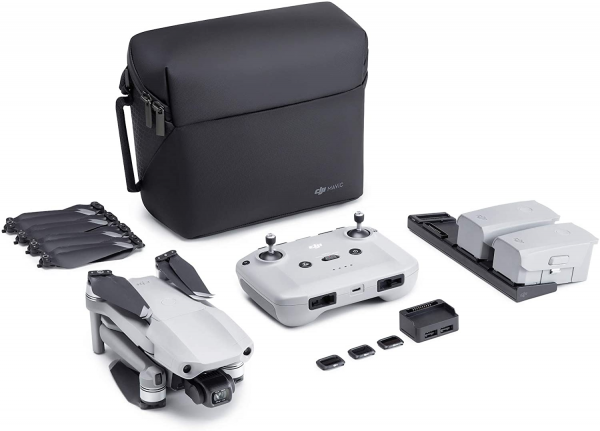DJI
DJI Mavic Air 2: the essence of Mavic 2 in a compact 4K drone
Aprox. 988€ - see price -
See specificationsSuccessor of the remarkable Mavic Air, the Mavic Air 2 was inevitably eagerly awaited. So here he is who lands in our hands with great promises, after more than 2 years of waiting. The Mavic 2 themselves would they have to worry?
Positive points
Good image quality.
Ocusync 2.0 link offering a very long range.
Video recording up to 4K Ultra HD at 60 fps.
Very good autonomy.
Easy steering, good stabilization.
DJI Fly application pleasant to use and complete enough for general public use.
Many automated shooting modes.
High performance obstacle avoidance.
Automatic subject tracking.
Good manufacturing quality.
Bad points
Recharge batteries only via the proprietary charger.
No side and top obstacle sensors.
More compact and therefore less easily transportable than the Mavic Air.
Our review
Presentation
DJI having already released the successors of Mavic Pro (Mavic 2 Pro and Mavic 2 Zoom in August 2018) and Spark (Mavic Mini in October 2019), only one Mavic Air replacement was missing this year to complete the renewal of consumer drones from the Chinese manufacturer. So it's done with the Mavic Air 2, launched on April 28, 2020, exactly 27 months after the first model (January 28, 2018).
With its price of € 849 and its 570 g, this quadrotor is positioned at the heart of the Mavic series, between the featherweight Mavic Mini (249 g; € 399) and the more high-end with a more professional vocation than the Mavic 2 Zoom (905 g; € 1,249) and Mavic 2 Pro (907 g; € 1,449).
Note that a "Fly More Combo" version is also available at € 1,049, adding 2 batteries, a carrying case, a 3-battery charger and a set of 3 filters for the camera.

Getting started
The first contact with this Mavic Air 2 can be somewhat disconcerting when you have known the Mavic Air and then discovered the Mavic 2. For good reason, the Mavic Air 2 completely puts aside the design of the first to adopt that of the second. The resemblance to the Mavic 2 is even such that one has the impression of being in front of a Mavic 2 Mini: similar proportions, taut lines repeated identically on the top of the device, battery and foldable arms of the identical drone ...
The manufacturing quality is also very similar to that of the Mavic 2, in other words very good. The device seems robust, no plastic cracks or even bends excessively, the assembly is impeccable. On the flip side, like its big brothers Mavic 2, the Mavic Air 2 has gained momentum compared to the first Mavic Air of the name. From 430 g, we actually go to 570 g. We stay well below the 905 g of a Mavic 2 Zoom and below the 800 g bar beyond which it is mandatory to declare the device and to have passed a training (which can be done for free on the site Alphatango), but the Mavic Air 2 still weighs more than 2 times heavier than a Mavic Mini (249 g).
Dimensions are also on the rise: folded, the newcomer measures 180 x 97 x 84 mm (L x W x H), that is 12 mm longer in length, 8 mm more in width and above all 35 mm more in height. The compactness of the Mavic Air is no longer, the comparison with a smartphone becoming much less obvious.
We realize that compactness is definitely sacrificed on the altar of comfort and functionality when we discover the supplied remote control. With a width of 15 cm, a height of 10 cm and a thickness of around 4.5 cm, it now looks like a Smart Controller, but without a screen and with integrated antennas. It is always here the smartphone that displays video feedback and all flight information. This fits into a clip on top. The sticks are fortunately always detachable, coming to be housed on the underside. The set will in any case take up much more space in a bag compared to the Mavic Air, and also weighs close to a kilogram (969 g), which could put off hikers, for example. The radio control remains essential to control the Mavic Air 2, since it integrates DJI's proprietary transceiver system Ocusync 2.0. A huge improvement over the Mavic Air, which offers link stability and a range far superior to the Mavic Air 2. DJI announces a range of 6 km (CE) or 10 km (FCC). We can in any case now fly several hundred meters without any problem - knowing all the same that we must in principle keep our drone in view and less than 150 m in height to comply with European legislation.
In terms of security, note that the radio remote control was supposed to incorporate DJI AirSense technology, but that this is initially reserved for copies sold in North America. DJI specifies that it has not been able to serve the rest of the world because of a shortage of components caused by the coronavirus epidemic. AirSense is based on the ADS-B air traffic monitoring system, used in particular to broadcast signals to indicate the positions of surrounding planes and helicopters, and thus to avoid accidents by alerting here the drone pilots of the approach of another apparatus. So we have to do without it for the moment in Europe.
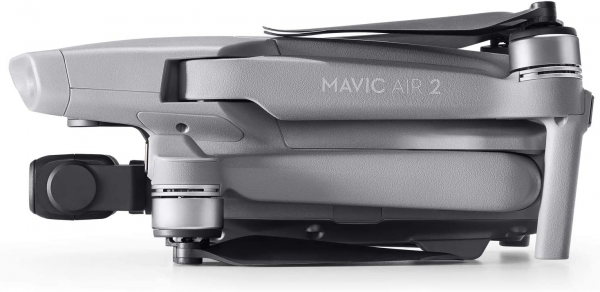
Flight
A few seconds are enough to get the Mavic Air 2 ready to take off. The deployment of its 4 arms is done in a jiffy. All you have to do is start it after taking care to remove the protection from its pod, then turn on its radio control previously connected to a smartphone running the DJI Fly app. Better to put the aircraft on the ground for takeoff and ensure that its surroundings are clear, since in case of loss of signal it will automatically return to its starting point (we will avoid taking off under a tree). The Mavic Air 2 can also reach the position of its remote control, if you decide to move a little during the flight, for example. Although DJI does not recommend it, it is also possible to take it off from our hand, taking care to bend the wrist to move our forearm away from the propellers (very sharp when they rotate). Same thing for the landing, taking there also infinite precautions. Avoid in case of wind, all the same, but it can allow to take off when the ground is irregular or covered with vegetation which would prevent the rotation of the propellers.
All that remains is to press the automatic take-off button for the aircraft to take off and position itself 1.2 m above its starting position, or else tilt the joysticks down and inside the radio control for manual takeoff. Totally stabilized, the Mavic Air 2 then remains in position as long as one does not touch the sticks, like any good drone designed for shooting. Just push the left stick to gain height and tilt it to turn, while the right stick is simply used to move forward, backward or move sideways. The control could not be more simple and reassuring, thanks to the good quality of the video return (up to 1080p at 30 fps on the smartphone) and to a sufficiently low latency (120 to 130 ms, according to DJI) which n 'not induce too much heaviness in the commands. Even beginners, after the impressive first minutes of flight, will quickly become comfortable.
It must be said that the Mavic Air 2 is packed with automatic devices, first of all its obstacle detection and avoidance system APAS 3.0 (Advanced pilot assistance system). This relies on 3 pairs of cameras (front, rear and under the aircraft) and a pair of time-of-flight (ToF) cameras to measure the distance between the drone and all that is up to 8 m below it). A detection system that operates up to a speed of 12 m / s, corresponding to the maximum speed in Normal mode. The faster Sport mode (19 m / s) cannot take advantage of this. Compared to the Mavic 2, we unfortunately lose the side and top sensors, which means that we have to be careful about lateral movements and not to fly under trees or bridges if we left the RTH active or if the '' we cannot be sure of recovering the device manually (in case of loss of radio link, it would risk an accident if it were to return automatically to its point of origin).
Similarly for most of the automated shooting modes that DJI offers on its Mavic Air 2, it is better to make sure that the surroundings are sufficiently clear before using one, and to remain attentive when the drone sets in motion. We are nevertheless delighted to find the 6 "QuickShots" (Rocket, Circle, Dronie, Helix, Boomerang and Asteroid) which allow you to obtain very successful camera effects without having to worry about driving and framing.
Even more convincing, the FocusTrack technology of the Mavic 2 is also part of it. Further improved, it makes the drone able to automatically follow the subject that it is indicated on the screen (person, car ...). We can then either control the movements manually (Spotlight 2.0), or let the drone move by following its subject (ActiveTrack 3.0). In the latter case, the fluidity has been improved and the Mavic Air 2 is better able to sneak between obstacles without causing sudden camera movements. Passing behind trees, for example, does not disrupt monitoring too much, the device managing to find its subject if its trajectory is predictable. We will not count too much on it to film a mountain bike excursion in the woods (too fast), but to easily keep a subject in the image on fairly wide shots, it is already quite convincing.
In terms of noise pollution, there has been progress compared to the deafening Mavic Air. With its slightly smaller two-bladed propellers, but very similar to those of the Mavic 2, the Mavic Air 2 emits a much duller noise, less irritating than the sharp noise of its predecessor. The device nevertheless remains noisier than a Mavic Mini; therefore do not expect to go unnoticed, even several tens of meters high.
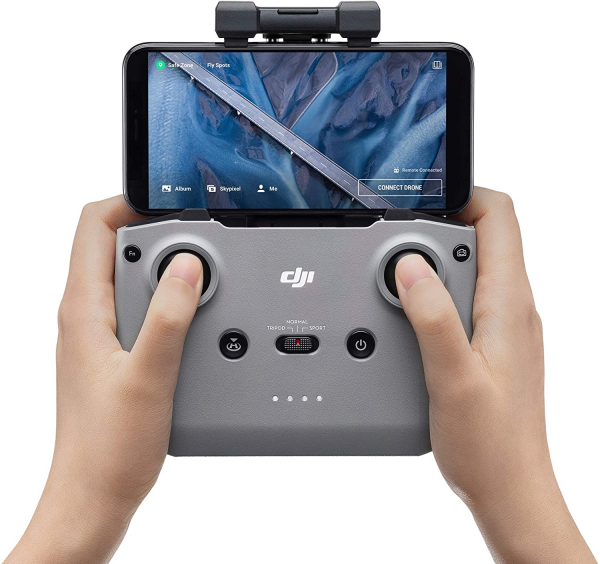
Image quality
Despite its greater compactness, the Mavic Air 2 has little to envy its big brothers Mavic 2 in terms of image quality. It also relies on a camera mounted on a gimbal stabilized on 3 axes. It is equipped with a 24 mm equivalent fixed focal length lens and opens up to f / 2.8. Behind it, a 1/2 "Quad Bayer" Cmos sensor (which could well be a Sony IMX586, but DJI does not specify it), capable of taking photos in 12 Mpx, but also in 48 Mpx. hope for better accuracy compared to the Cmos 1 / 2.3 "12 Mpx sensor of the Mavic 2 Zoom in particular.
In fact, the dive gain of 48 MP mode is not always obvious, but still present. In automatic mode, photos in 48 Mpx are a little more detailed, but also noisier than those in 12 Mpx, especially in low light. This can be explained by the very operation of a "Quad Bayer" sensor, although DJI does not explain the method allowing it to achieve such an image definition. Most of the time, we prefer to stay in 12 MP to take advantage of the pixel binning which allows to recover more light by grouping 4 pixels in one, and therefore to limit the need to increase in sensitivity.
The 12 MP software processing clearly plays on the accentuation of the micro-contrasts and pushes the color saturation a little, producing more flattering shots. However, this remains reasonable and the photos obtained are generally perfectly usable without retouching. In manual mode on the other hand, under fairly bright conditions, the 48 Mpx can be used more easily, in particular if one is ready to do a little post-processing, since the Mavic Air 2 is capable of producing raw files (Raw) in addition to Jpeg.
The DJI Fly application may be simplified compared to the DJI Go is Mavic 2 app, it still offers interesting options and in particular a manual mode allowing to adjust aperture, exposure and sensitivity (up to ISO 3200 48 MP and ISO 6,400 in 12 MP and video). There is also a histogram and a display of the overexposed areas.
On the video side, the Mavic Air 2 goes as far as surpassing the Mavic 2, offering Ultra HD 4K at 60 fps with a maximum speed of 120 Mb / s. Its big brothers are limited to respectively 30 i / s and 100 Mb / s. As a result, more fluidity, especially in camera rotations and traveling shots. HDR mode can however only work up to 30 fps in 4K UHD. It is therefore necessary to alternate between the 2 possibilities depending on the type of scene to be filmed, to favor either fluidity or dynamics. The Mavic Air 2's sensor also allows 1080p slowdowns at 120 fps or 240 fps which add to the creative possibilities.
Our tests reveal good management of automatic mode, despite a fairly rapid increase in sensitivity. The result is very clean, with a noticeable swarm in low light, but a good general sharpness and a homogeneous scene. There are pretty flattering colors by default. The amateurs of neutrality who want to be able to intervene more finely on the rendering will turn to recording in D-Cinelike.
The Mavic Air 2 having been loaned to us by DJI prior to its commercial release, some functions were still absent at the time of writing this test, such as the Hyperlapse 8K. We will try to borrow the device again in a few weeks to test the latter mode in particular.
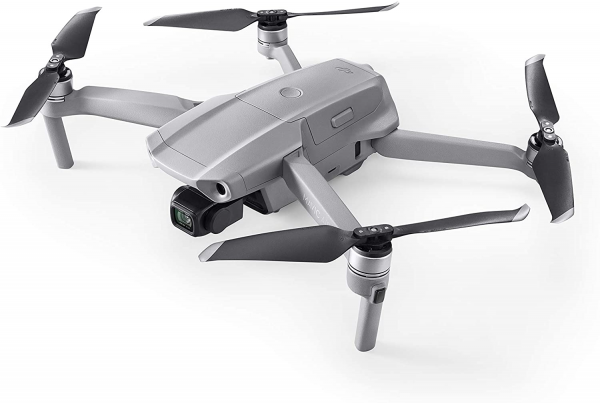
Autonomy
With its 3,500 mAh LiPo 3S battery, the Mavic Air 2 promises up to 34 minutes of flight time, far outperforming the Mavic Air and its 2,350 mAh battery. The main reasons for the weight gain of the Mavic Air 2 can be found here! The newcomer can even fly 3 minutes longer than the Mavic 2 and their 3,850 mAh battery and 4 minutes longer than a Mavic Mini. Unsurprisingly, the 34 minutes can only be reached in ideal conditions, without wind and by draining the battery to the maximum, which is hardly recommendable. In normal use, however, when we simply deactivate the first automatic return home warning that the application shows us, we can count on a little thirty minutes of flight according to our tests (25 at least, except execrable conditions). ), which is already excellent when you know that a Mavic 2 usually takes 20 to 25 minutes.
Charging takes approximately 1 hour 30 minutes (or even fifteen minutes more when the battery has been completely discharged), but can only be carried out with the charger provided, proprietary connector requires. Too bad we can not load it directly from the USB-C port of the drone (which is only used for connection to a computer), especially as this is possible on the Mavic Mini. Lovers of long filmed sequences can nevertheless turn to the Fly More Combo pack including 3 batteries and a charger allowing them to be charged at the same time.
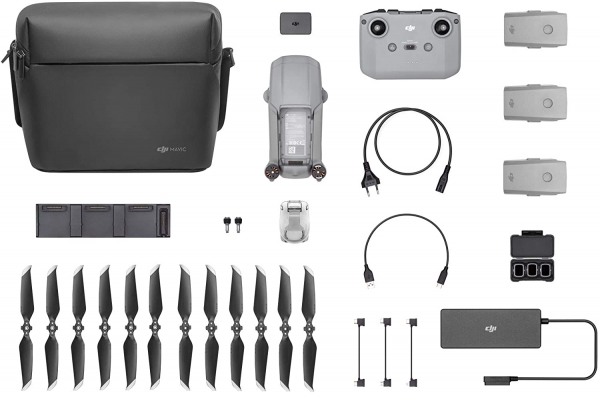
Conclusion
Like its predecessor, the Mavic Air 2 turns the market upside down by offering features previously reserved for higher-end drones, first of all a long-range link that was lacking in the first model. Remarkably easy to use, it rivals the Mavic 2 in certain respects, even offering the luxury of even smoother video recording. If it is unfortunately not as easy to transport as the first Mavic Air, the Mavic Air 2 justifies its overweight by a significantly greater autonomy. Undoubtedly the best drone at less than 1000 € at the moment.
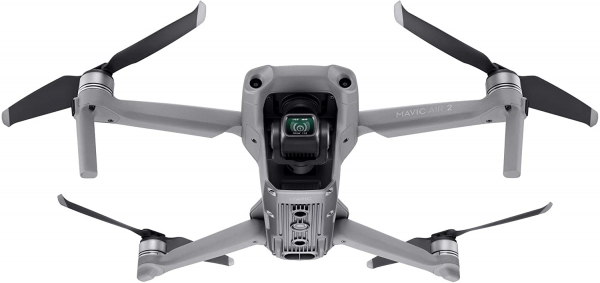
Specifications

